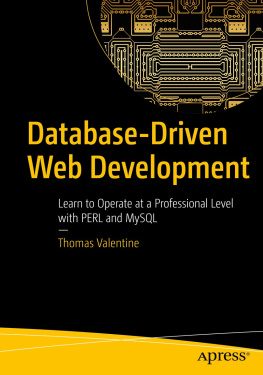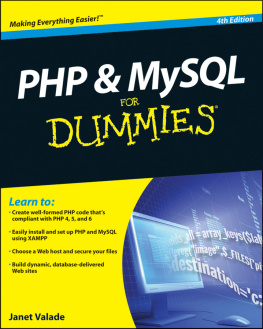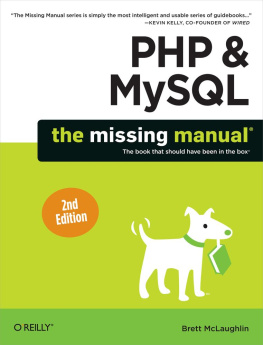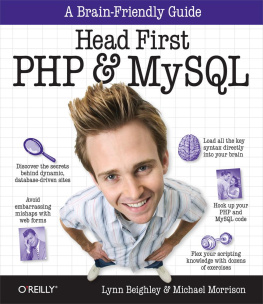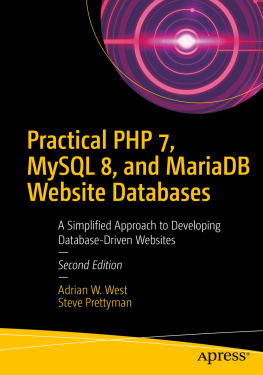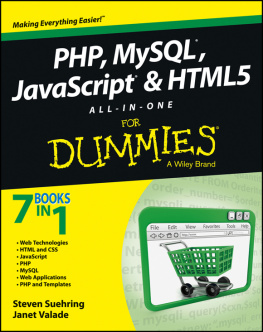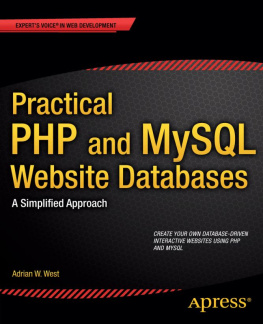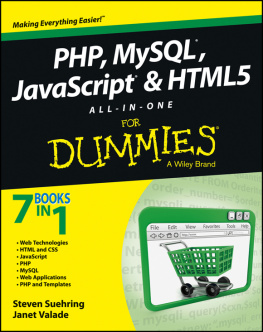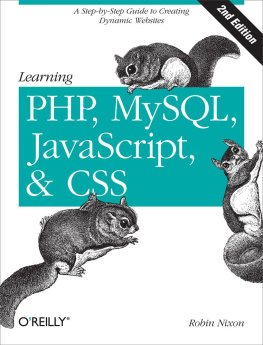There are lots of PHP and MySQL resources. So why did we decide to add this book to the market? We made the decision after we started teaching graduate students how to program with PHP in 1999. We found that the PHP and MySQL manuals, as well as most books, train people to use particular tools. But almost no resources explained the principles of programming for the Web. We realized that Web administrators and programmers needed to know more than what PHP functions to use and how to write SQL queries. That's where this book comes in: it'll help you learn about web database development, as well as understand the principles.
This book explains what to do and why, along with how it's done in PHP and MySQL. You'll find information here that you won't find elsewhere. Hopefully, you'll use this knowledge with whatever web tools you choose in the future. But you'll also learn about the breadth and depth of PHP and MySQL. When you finish this book, you'll be able to build an online store, a portal, or a content management system.
What This Book Is About
This book is for developers who want to build database applications that are integrated with the Web. We show you the principles and techniques for developing small- to medium-scale web database applications that store, manage, and retrieve data. The architecture we describe is a successful framework for applications that can run on modest hardware and process more than a million hits per day.
We show you all of the critical tasks you need to know to build successful web software. We cover programming fundamentals for the Web. We show you the principles and practice of working with databases using the SQL query language. We teach you about tracking users with sessions, securing an application, separating presentation from code, writing database-independent code, writing reports, adding error handling, and advanced object-oriented and database topics.
An important feature of this book is our case study, Hugh and Dave's Online Wines . It's a complete but fictional online retail store that illustrates how most of the techniques described in the book can be put together to build a real application. The winestore application allows users to browse and search a database of wines, add items to a shopping cart, manage their membership, and purchase wines. It has all the basic security, user-tracking, and error-handling features of a real-world application. It features a medium-size database that we use in querying examples throughout the book.
We use Open Source software, and we show you how to use it on Unix-based platforms such as Linux and Mac OS X, and under Microsoft Windows 2000, 2003, and XP. Our database server is MySQL, a system known for its suitability to applications that require speed but low resource overheads. Our scripting language is PHP, which is best known for its function libraries that interact with more than 15 relational database systems, the web environment, and many other services. Apache is our web server of choice, but most other web servers can be used successfully with MySQL, PHP, and this book.
What You Need to Know
This book is about understanding and developing application logic that brings databases and the Web together. We introduce database systems over the course of the book, but our discussions don't replace a book or class dedicated to relational database theory, or a book about a specific relational database system such as MySQL. Likewise, we assume you're already familiar with the Web. We don't delve deeply into the three key web protocols, HTML, HTTP, and TCP/IP.
You don't need to know how to program to use this book, but you do need to understand basic HTML. Our introduction to PHP doesn't assume you are familiar with web scripting or are a programmer, but we do assume you understand the basic HTML constructs and are familiar with the popular web browsers. If you can use a text editor to author an HTML document that contains a form and a table, you have sufficient HTML skills to use this book. It's the principles of structure in the markup process that are important, not the attractiveness or usability of the presentation in the web browser.
You don't need a detailed understanding of relational databases to use this book, but a working knowledge is helpful. We present the relational database theory needed for developing simple applications, and we cover many other basic concepts, including how to tell when a database is the method of choice to store data, the database query language SQL, and a case study that models system requirements and converts the model to a database design. This book isn't a substitute for the many good resources on database theory. However, it's enough to begin developing the underlying databases for many web database applications.
We briefly introduce web servers and networking in . Both web servers and networking are important to a web database application but aren't the focus of this book. We present enough information to set up a web server and to understand how it fits in the architecture of a web database application. For many applications, this is sufficient. Likewise, we present sufficient detail so that you will understand what networking and network protocol issues impact web database application design.
How This Book Is Organized
There are 20 chapters and 8 appendixes in this book. introduce web database applications, PHP, MySQL, and SQL:
Discusses the three-tier architecture commonly used in web database applications, and how data is exchanged between browsers and servers. It introduces PHP and MySQL, and discusses when and why databases are used on the Web. The features of MySQL 4.1 and PHP5 are introduced.
Introduces the PHP scripting language. It covers programming in PHP and discusses the basic programming constructs, variables, types, functions, and techniques.
Explains the intermediate level features of PHP, including how to work with arrays, strings, and times and dates. The chapter is illustrated with many short examples that show how each technique is used in practice.
Shows you how to use the basic object-oriented (OO) features of PHP4 and PHP5, and explains why OO programming is popular and becoming important in PHP. A more advanced discussion of the new OO features in PHP5 is presented in .
Introduces MySQL and how to interact with it using the SQL query language. The focus of the chapter is an example-driven section on querying, and we illustrate it using examples from the online winestore's database. We also introduce you to the basics of creating, deleting, and updating data and databases. A more advanced discussion of the features of MySQL 4.1 is presented in .


